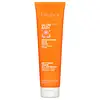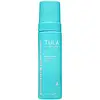What's inside
What's inside
 Key Ingredients
Key Ingredients

 Benefits
Benefits

 Concerns
Concerns

 Ingredients Side-by-side
Ingredients Side-by-side

Water
Skin ConditioningCocamidopropyl Betaine
CleansingSodium Methyl 2-Sulfolaurate
CleansingDisodium 2-Sulfolaurate
CleansingGlycolic Acid
BufferingLactic Acid
BufferingGlycerin
HumectantAloe Barbadensis Leaf Juice
Skin ConditioningMagnesium Ascorbyl Phosphate
AntioxidantMalic Acid
BufferingAllantoin
Skin ConditioningCitric Acid
BufferingSucrose Cocoate
EmulsifyingPotassium Sorbate
PreservativeSodium Riboflavin Phosphate
Skin ConditioningPhenoxyethanol
PreservativeVanilla Planifolia Fruit Extract
Skin ConditioningParfum
MaskingWater, Cocamidopropyl Betaine, Sodium Methyl 2-Sulfolaurate, Disodium 2-Sulfolaurate, Glycolic Acid, Lactic Acid, Glycerin, Aloe Barbadensis Leaf Juice, Magnesium Ascorbyl Phosphate, Malic Acid, Allantoin, Citric Acid, Sucrose Cocoate, Potassium Sorbate, Sodium Riboflavin Phosphate, Phenoxyethanol, Vanilla Planifolia Fruit Extract, Parfum
Salicylic Acid 2%
MaskingWater
Skin ConditioningSodium Methyl 2-Sulfolaurate
CleansingDisodium 2-Sulfolaurate
CleansingDisodium Laureth Sulfosuccinate
CleansingLactococcus Ferment Lysate
Skin ConditioningMelaleuca Alternifolia Leaf Oil
AntioxidantAzelaic Acid
BufferingMorinda Citrifolia Extract
AstringentGlycyrrhiza Glabra Root Extract
BleachingVaccinium Angustifolium Fruit Extract
Skin ProtectingZingiber Officinale Root Extract
MaskingLactic Acid
BufferingHydrolyzed Algin
Glycerin
HumectantCitric Acid
BufferingPhospholipids
Skin ConditioningCaprylyl Glycol
EmollientSodium Chloride
MaskingBenzoic Acid
MaskingSodium Hydroxide
BufferingSodium Glycolate
BufferingTrisodium Dicarboxymethyl Alaninate
Butylene Glycol
HumectantChlorphenesin
AntimicrobialSodium Benzoate
MaskingEthylhexylglycerin
Skin ConditioningPhenoxyethanol
PreservativeSalicylic Acid 2%, Water, Sodium Methyl 2-Sulfolaurate, Disodium 2-Sulfolaurate, Disodium Laureth Sulfosuccinate, Lactococcus Ferment Lysate, Melaleuca Alternifolia Leaf Oil, Azelaic Acid, Morinda Citrifolia Extract, Glycyrrhiza Glabra Root Extract, Vaccinium Angustifolium Fruit Extract, Zingiber Officinale Root Extract, Lactic Acid, Hydrolyzed Algin, Glycerin, Citric Acid, Phospholipids, Caprylyl Glycol, Sodium Chloride, Benzoic Acid, Sodium Hydroxide, Sodium Glycolate, Trisodium Dicarboxymethyl Alaninate, Butylene Glycol, Chlorphenesin, Sodium Benzoate, Ethylhexylglycerin, Phenoxyethanol
 Reviews
Reviews

Ingredients Explained
These ingredients are found in both products.
Ingredients higher up in an ingredient list are typically present in a larger amount.
Citric Acid is an alpha hydroxy acid (AHA) naturally found in citrus fruits like oranges, lemons, and limes.
Like other AHAs, citric acid can exfoliate skin by breaking down the bonds that hold dead skin cells together. This helps reveal smoother and brighter skin underneath.
However, this exfoliating effect only happens at high concentrations (20%) which can be hard to find in cosmetic products.
Due to this, citric acid is usually included in small amounts as a pH adjuster. This helps keep products slightly more acidic and compatible with skin's natural pH.
In skincare formulas, citric acid can:
While it can provide some skin benefits, research shows lactic acid and glycolic acid are generally more effective and less irritating exfoliants.
Most citric acid used in skincare today is made by fermenting sugars (usually from molasses). This synthetic version is identical to the natural citrus form but easier to stabilize and use in formulations.
Read more about some other popular AHA's here:
Learn more about Citric AcidWe don't have a description for Disodium 2-Sulfolaurate yet.
Glycerin is already naturally found in your skin. It helps moisturize and protect your skin.
A study from 2016 found glycerin to be more effective as a humectant than AHAs and hyaluronic acid.
As a humectant, it helps the skin stay hydrated by pulling moisture to your skin. The low molecular weight of glycerin allows it to pull moisture into the deeper layers of your skin.
Hydrated skin improves your skin barrier; Your skin barrier helps protect against irritants and bacteria.
Glycerin has also been found to have antimicrobial and antiviral properties. Due to these properties, glycerin is often used in wound and burn treatments.
In cosmetics, glycerin is usually derived from plants such as soybean or palm. However, it can also be sourced from animals, such as tallow or animal fat.
This ingredient is organic, colorless, odorless, and non-toxic.
Glycerin is the name for this ingredient in American English. British English uses Glycerol/Glycerine.
Learn more about GlycerinLactic Acid is another well-loved alpha hydroxy acid (AHA). It is gentler than glycolic acid but still highly effective.
Its main role is to exfoliate the surface of the skin by loosening the “glue” that holds dead skin cells together. Shedding those old cells leads to smoother, softer, and more even-toned skin.
Because lactic acid molecules are larger than glycolic acid, they don’t penetrate as deeply. This means they’re less likely to sting or irritate, making it a great choice for beginners or those with sensitive skin.
Like glycolic acid, it can:
Lactic acid also acts as a humectant (like hyaluronic acid). It can draw water into the skin to improve hydration and also plays a role in the skin's natural moisturizing factor (NMF) in the form of sodium lactate.
Studies show it can boost ceramide production to strengthen the skin barrier and even help balance the skin’s microbiome.
To get results, choose products with a pH between 3-4.
Lower strengths (5-12%) focus on surface exfoliation; higher strengths (12% and up) can reach deeper in the dermis (deeper, supportive layer) to improve skin texture and firmness over time.
Though it was originally derived from milk, most modern lactic acid used in skincare is vegan. It is made through non-dairy fermentation to create a bio-identical and stable form suitable for all formulations.
When lactic acid shows up near the end of an ingredient list, it usually means the brand added just a tiny amount to adjust the product’s pH.
Legend has it that Cleopatra used to bathe in sour milk to help reduce wrinkles.
Lactic acid is truly a gentle multitasker: it exfoliates, hydrates, strengthens, and brightens. It's a great ingredient for giving your skin a smooth, glowing, and healthy look without the harshness of stronger acids.
Read more about some other popular AHA's here:
Learn more about Lactic AcidPhenoxyethanol is a preservative that has germicide, antimicrobial, and aromatic properties. Studies show that phenoxyethanol can prevent microbial growth. By itself, it has a scent that is similar to that of a rose.
It's often used in formulations along with Caprylyl Glycol to preserve the shelf life of products.
We don't have a description for Sodium Methyl 2-Sulfolaurate yet.
Water. It's the most common cosmetic ingredient of all. You'll usually see it at the top of ingredient lists, meaning that it makes up the largest part of the product.
So why is it so popular? Water most often acts as a solvent - this means that it helps dissolve other ingredients into the formulation.
You'll also recognize water as that liquid we all need to stay alive. If you see this, drink a glass of water. Stay hydrated!
Learn more about Water